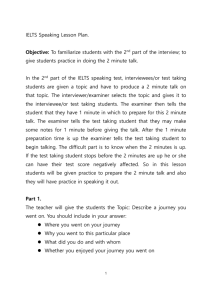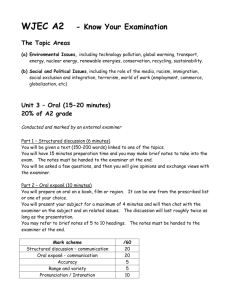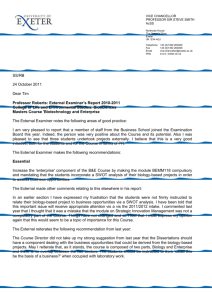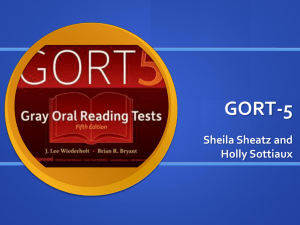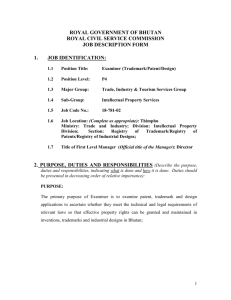Frontal Assessment Battery (FAB): Cognitive Assessment Tool
advertisement
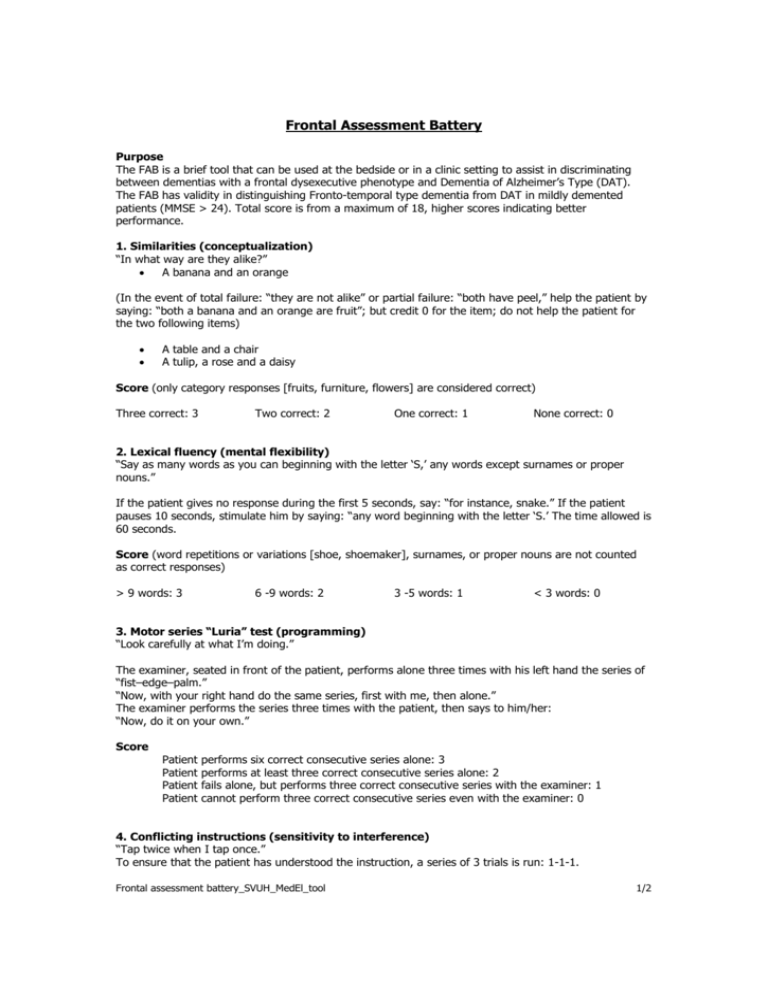
Frontal Assessment Battery Purpose The FAB is a brief tool that can be used at the bedside or in a clinic setting to assist in discriminating between dementias with a frontal dysexecutive phenotype and Dementia of Alzheimer’s Type (DAT). The FAB has validity in distinguishing Fronto-temporal type dementia from DAT in mildly demented patients (MMSE > 24). Total score is from a maximum of 18, higher scores indicating better performance. 1. Similarities (conceptualization) “In what way are they alike?” A banana and an orange (In the event of total failure: “they are not alike” or partial failure: “both have peel,” help the patient by saying: “both a banana and an orange are fruit”; but credit 0 for the item; do not help the patient for the two following items) A table and a chair A tulip, a rose and a daisy Score (only category responses [fruits, furniture, flowers] are considered correct) Three correct: 3 Two correct: 2 One correct: 1 None correct: 0 2. Lexical fluency (mental flexibility) “Say as many words as you can beginning with the letter ‘S,’ any words except surnames or proper nouns.” If the patient gives no response during the first 5 seconds, say: “for instance, snake.” If the patient pauses 10 seconds, stimulate him by saying: “any word beginning with the letter ‘S.’ The time allowed is 60 seconds. Score (word repetitions or variations [shoe, shoemaker], surnames, or proper nouns are not counted as correct responses) > 9 words: 3 6 -9 words: 2 3 -5 words: 1 < 3 words: 0 3. Motor series “Luria” test (programming) “Look carefully at what I’m doing.” The examiner, seated in front of the patient, performs alone three times with his left hand the series of “fist–edge–palm.” “Now, with your right hand do the same series, first with me, then alone.” The examiner performs the series three times with the patient, then says to him/her: “Now, do it on your own.” Score Patient Patient Patient Patient performs six correct consecutive series alone: 3 performs at least three correct consecutive series alone: 2 fails alone, but performs three correct consecutive series with the examiner: 1 cannot perform three correct consecutive series even with the examiner: 0 4. Conflicting instructions (sensitivity to interference) “Tap twice when I tap once.” To ensure that the patient has understood the instruction, a series of 3 trials is run: 1-1-1. Frontal assessment battery_SVUH_MedEl_tool 1/2 “Tap once when I tap twice.” To ensure that the patient has understood the instruction, a series of 3 trials is run: 2-2-2. The examiner then performs the following series: 1-1-2-1-2-2-2-1-1-2. Score No errors: 3 1 -2 errors: 2 > 2 errors: 1 Patient taps like the examiner at least four consecutive times: 0 5. Go–No Go (inhibitory control) “Tap once when I tap once.” To ensure that the patient has understood the instruction, a series of 3 trials is run: 1-1-1. “Do not tap when I tap twice.” To ensure that the patient has understood the instruction, a series of 3 trials is run: 2-2-2. The examiner then performs the following series: 1-1-2-1-2-2-2-1-1-2. Score No errors: 3 1 -2 errors: 2 > 2 errors: 1 Patient taps like the examiner at least four consecutive times: 0 6. Prehension behaviour (environmental autonomy) “Do not take my hands.” The examiner is seated in front of the patient. Place the patient’s hands palm up on his knees. Without saying anything or looking at the patient, the examiner brings his own hands close to the patient’s hands and touches the palms of both the patient’s hands, to see if he will spontaneously take them. If the patient takes the examiner’s hands, try again after asking the patient: “Now, do not take my hands.” Score Patient Patient Patient Patient does not take the examiner’s hands: 3 hesitates and asks what he/she has to do: 2 takes the hands without hesitation: 1 takes the examiner’s hand even after he/she has been told not to do so: 0 Interpreting results A cut off score of 12 on the FAB has a sensitivity of 77% and specificity of 87% in differentiating between frontal dysexecutive type dementias and DAT ReferenceS Dubois, B. ; Litvan, I.; The FAB: A frontal assessment battery at bedside. Neurology. 55(11): 16211626, 2000. Slachevsky, A; Dubois, B. Frontal Assessment Battery and Differential Diagnosis of Frontotemporal Dementia and Alzheimer Disease. Archives of Neurology. 61(7): 1104-1107, 2004. Frontal assessment battery_SVUH_MedEl_tool 1/2
